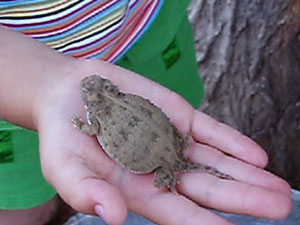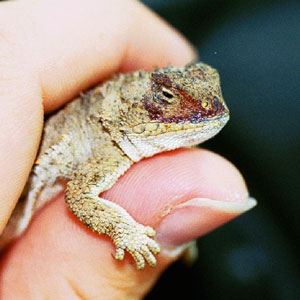


Short-horned Lizard (Phrynosoma douglassii)
Description: Short-horned lizards are small, flat, round lizards that have short, stubby horns. The "horns" are actually a crown of short pointed scales on the back of the head. Like other horned lizards, they have a series of pointed scales along the edge of the body. The short tail is thin and pointed. 
The color varies depending upon the animal's surroundings, since their color provides them with camouflage. The color generally ranges from red-brown to yellow-grey. They have about twelve dark blotches on the back - arranged in rows - that add to the body camouflage. They are cryptic animals so their coloration usually matches the color of the soil and rocks where they live. The underside is white, light gray/yellow without spots. How big are they? These are small and light weight animals. Large adults can be about 10 cm (4 inches) long, but many specimens are smaller. An adult lizard can easily fit in the palm of a child's hand. Weight: 4.5 - 5.6 grams (about the weight of a Nickel [5.0 grams] or a Quarter [5.67 grams] )
Size: 8 to 10 cm (3.5 - 4 inches) - length from the nose to the tip of the tail Phrynosoma douglasii commonly occurs throughout the Columbia Basin and the Cascades foothills in a variety of habitats including sagebrush plains, short-grass prairies and occasionally in open pine forests. Always found near patches of loose soil or sand for burrowing. The substrate (soil layer) is always well-drained. However, this species is uncommon in steppe and intermountain forest. This species is found near ant hills. Click the range map to learn more about the distribution of Short-horned Lizards in Washington. Diet: Short-horned Lizards are insectivores. They eat ants, beetles and small pebbles. Neonates prefer ants, yearlings like beetles and adults eat both ants and beetles. 
Behavior: Adults can handle cold and partially freeze. They are normally active between 60-80 degrees F. During hot weather, Short-horned Lizards are most active during the morning hours, with less activity in the afternoon. They prefer soft, sandy soils, near rocks where they can blend in with the background. Short-horned Lizards can quickly burrow into loose soil to hide. They use their small claws for digging and climbing. They capture ants with their long sticky tongue. Watch out - They Squirt Blood! If threatened by predators, horned lizards will squirt blood from the eyes. The squirting blood comes from ducts in the corners of their eyes and can travel a distance of up to three feet (one meter). It's meant to confuse would-be predators including birds, coyotes and snakes. The photo shows an adult with blood around the eyes. Watch a video of a lizard squirting blood » 
Reproduction: Short-horned Lizards emerge from hibernation from late March into June. Mating occurs soon after the emerge. Males of this species are territorial and advertise their territories with head bobbing displays. If a receptive female enters his territory, the male and female will bob heads briefly before mating. They are the only species of horned toads that give birth to the young live. Other species of horned lizards lay eggs. In the Short-horned lizard the eggs are retained within the mother until live young are born about two months later (August to mid-September). Short-horned Lizards give birth to 7-10 babies. The newborn are very small - measuring about 25 mm (1 inch) long.
Did you know?

Short-horned Lizard, adult female with neonates More information: Horny Toads - Adopt-A-Farmer Project Short-horned Lizard - Animal Diversity Web |
Animal silhouettes available to purchase »
Home | About Us | How to Participate | Biodiversity Modules | Projects | Maps | News | Resources